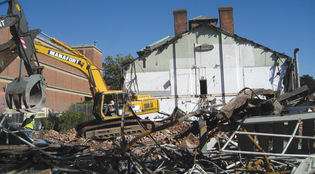 loading
loading
Light & VerityBuildings come down, wall stays up Jacqueline NelsonWorkers began demolishing Hammond Hall in October to make room for two residential colleges. Seeley Mudd Library, at left in photo, is also slated to be torn down. View full imageFor a project that is officially on hold, the planned construction of two new residential colleges at Yale is generating its share of local controversy. As demolition begins, preservationists are bemoaning the loss of 13 buildings of varying pedigrees on the site, and still hoping to persuade Yale to spare one or more of them. And in October, a board member of the nearby Grove Street Cemetery put forward a proposal to replace some of the cemetery's stone wall with iron fencing; the proposal, which some saw as an effort to accommodate Yale's plans for the area, met strong resistance and was quickly withdrawn. Preservationists first voiced their objections in July, after plans were unveiled indicating that all 13 existing buildings on the 6.5-acre site (on Prospect Street north of the cemetery) would be demolished. The New Haven Historic District Commission drafted a letter objecting to “mass demolition,” singling out the 105-year-old Hammond Hall and the 119-year-old Daniel Cady Eaton House. But the commission had no power to prevent the demolition, and Yale started tearing down the Eaton House, Hammond Hall, and four other buildings on the site in October. Others objected to the decision to demolish the Seeley Mudd Library, built in 1982 as a repository for government documents and seldom-requested books. Yale had indicated early on that it might incorporate Mudd into its plans, but University Planner Laura Cruickshank said in May that “getting further into site planning, we realized we couldn't fit the colleges around the library.” Architect Harold Roth ’57MArch, whose firm designed Mudd, believes the building is well suited for music practice rooms, seminar rooms, and study space—all spaces that are part of the plans for the new colleges. “It seems a little bit inconsistent to tout the university’s support for sustainability in its new buildings and yet go ahead and demolish recently constructed buildings that have value,” says Roth. If the preservation community had little luck saving buildings, it notched a victory over the cemetery wall. The idea of replacing sections of the wall on Prospect Street with open iron fencing had been mentioned in a 2008 Yale report on the feasibility of the new colleges; the idea was that opening up the wall would make the walk between the new colleges and the central campus less forbidding. The proposal—designed by School of Architecture dean Robert A. M. Stern ’65MArch—was brought before the cemetery’s governing board by one of its members, Charles Ellis ’59. Ellis is a former Yale trustee who is married to University Secretary and Vice President Linda Koch Lorimer ’77JD. The cemetery board considered the proposal at its annual meeting on October 6, which was open to the public. A number of people, including some with family plots, showed up to object that opening the wall would intrude on the quiet of the place. Within a week, the board announced that Ellis had withdrawn the proposal. The board said it would consider ideas for landscaping the Prospect Street wall to make it more inviting. While Yale works to clear the site for the new colleges, there are no signs that the project—which would allow a 15 percent expansion in undergraduate enrollment—will get started in the foreseeable future. The university has called a halt to all new construction not underwritten by donors.
The comment period has expired.
|
|